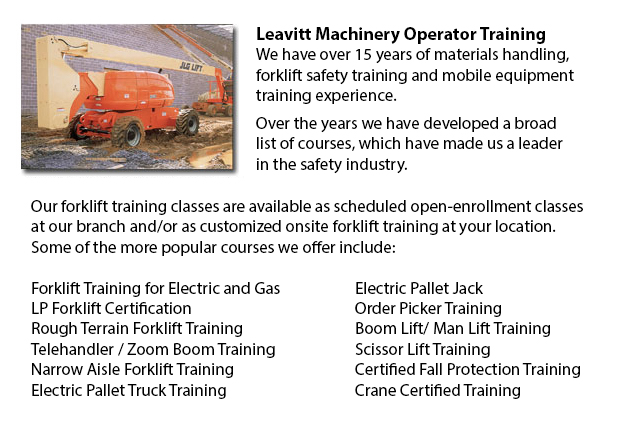
Boom Lift Safey Training Goodyear - Boom lifts are a type of aerial lifting device or elevated work platform that are usually utilized in industry, warehousing and construction. Boom lifts could be used in practically any setting due to their versatility.
Elevated work platforms enable personnel to access work places that will be unreachable otherwise. There is inherent danger in the operation of these devices. Employees who operate them have to be trained in the right operating methods. Accident avoidance is paramount.
The safety factors that are involved in using boom lifts are covered in our Boom Lift Training Programs. The course is best for those who operate self-propelled boom supported elevated work platforms and self-propelled elevated work platforms. Upon successful completion of the course, Those who participated would be given a certificate by somebody qualified to confirm completing a hands-on assessment.
In order to help train operators in the safe utilization of elevated work platforms, industry agencies, local and federal regulators, and lift manufacturers all play a role in establishing standards and providing the necessary information. The most essential ways in preventing accidents connected to the use of elevated work platforms are as follows: conducting site assessments; checking machines; and putting on safety gear.
Important safety considerations when operating Boom lifts:
Operators stay away from power line, observing the minimum safe approach distance (or also known as MSAD). Voltage could arc across the air to find an easy path to ground.
A telescopic boom must be retracted before lowering a work platform in order to maintain stability when the platform nears the ground.
Boom lift workers must tie off to guarantee their safety. The lanyard and safety apparatus should be attached to manufacturer provided anchorage, and never to other wires or poles. Tying off may or may not be necessary in scissor lifts, that depends on specific job risks, local regulations, or employer guidelines.
Avoid working on a slope that goes beyond the maximum slope rating as specified by the manufacturer. If the slop exceeds requirements, then the machine should be transported or winched over the slope. A grade could be easily measured by laying a minimum 3-feet long straight board or edge on the slope. Next a carpenter's level can be laid on the straight edge and raising the end until it is level. The per-cent slope is attained by measuring the distance to the ground (also known as the rise) and then dividing the rise by the length of the straight edge. Afterward multiply by 100.
-
Crane / Overhead Crane / Truck Mounted Crane / Hydraulic Cranes Training in Goodyear
Bridge cranes or likewise called overhead cranes are a kind of industrial material handling crane making use of a line and hook device that runs on a horizontal beam running along two widely separated rails. Many overhead cranes can be seen inside a... More -
Fantuzzi Parts
The Italian Fantuzzi Group offers a glut of material handling equipment and heavy machinery. The equipment consists of numerous equipment specializing in transporting, loading and unloading goods. The railway freight sector and the port authority req... More -
Forklift Training School Goodyear
Forklift Training School Goodyear - Why A Forklift Training School Could Actually Help A Business And Its Employees - CSA and OSHA establish criteria for forklift safety training that meets existing regulations and standards. Anyone intending to oper... More -
Warehouse Forklift Training Classes Goodyear
Warehouse Forklift Training Classes Goodyear - The purpose of warehouse training classes are to raise the awareness of common workplace hazards. The trainees would learn necessary warehouse safety measures. An emphasis is placed on paying attention t... More -
Aerial Lift Ticket Goodyear
Aerial Lift Ticket Goodyear - A boom truck is frequently recognized by the cable and phone business vehicles that have the long arm folded over their roofs. Usually, a bucket-like apparatus sits at the extension of extendable arms. Sometimes termed a... More -
Telehandler Ticket Goodyear
Telehandler Ticket Goodyear - The telescopic handler or telehandler is a generally used equipment in agricultural and industrial applications. This machine is similar in look to a forklift and even works in a similar way, even though telehandlers are... More -
Scissor Lift Safety Training Goodyear
Scissor Lift Safety Training Goodyear - A Scissor Lift is a practical type of platform that normally moves in a vertical direction. The equipment is capable of this movement because of the use of folding supports that are linked in a criss-cross patt... More -
Aerial Boom Lift Training Goodyear
Aerial Boom Lift Training Goodyear - For individuals who operate or supervise the use of aerial lift platforms, right aerial boom lift Training is necessary. The aerial lift platform is for lifting individuals, materials and tools to elevated work lo... More

Forklift Training Goodyear
TOLL FREE: 1-888-254-6157
Goodyear, Arizona
forkliftcertificationgoodyear.com
Email Us
About Us


